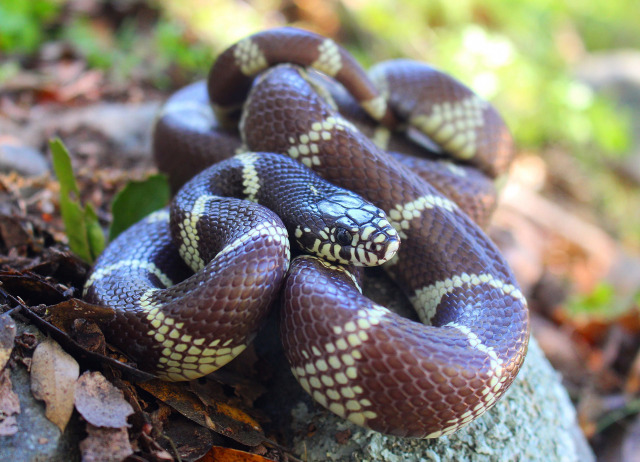The California king snake is driving reptiles exclusive to Gran Canaria to extinction
An article by Julien C. Piquet and Marta López Darias, published in Proceedings of the Royal Society B: Biological Sciences, highlights the decline in populations of endemic reptiles on the island of Gran Canaria.
The journal Proceedings of the Royal Society B: Biological Sciences has published in its December issue an article by IPNA researchers Julien C. Piquet and Marta López Darias, describing the impact that the introduction of the California king snake (Lampropeltis californiae) is having on the endemic reptiles of Gran Canaria. This project was possible thanks to the support of the BBVA Foundation, the Canary Islands Government and the island Cabildo of Gran Canaria, in collaboration with the public environmental enterprise GESPLAN.The article has been reviewed by the prestigious journal Nature under the title Snake escape: imported reptiles gobble an island’s lizards.
The California king snake was introduced onto Gran Canaria in 1998. Since then its population has not stopped growing, despite efforts since 2009 by the Canary Islands Government and the Cabildo of Gran Canaria to contain its expansion. This highly invasive predator feeds mainly on endemic reptiles, as well as consuming introduced rodents such as mice and rats. Although there was a previous assessment of the effects that Lampropeltis californiae was having on the giant lizard of Gran Canaria Gallotia stehlini over a small area, work by researchers Julien C. Piquet and Marta López Darias has now quantitatively assessed the impact of this invasive species on the populations of the three reptiles endemic to the island. These are the aforementioned giant lizard, the Gran Canaria skink, Chalcides sexlineatus, and Boettger's gecko, Tarentola boettgeri.
The results leave no doubt about the devastating consequences the California king snake is having on the fragile biodiversity of the island. These IPNA-CSIC scientists have discovered that the snakes are feeding on these reptiles to the point of practically exterminating them from the natural environment of Gran Canaria. The giant lizard is almost extinct in the areas invaded by the snake, with 99 % having disappeared, the Gran Canaria skink has decreased in number by more than 80 % and Boettger's gecko has reduced its population by a half.
The figures highlight the serious ecological impact caused by this invasive snake. If its spread is not halted, the consequences will be irreversible and lead to other problems. As Piquet and López-Darias point out, the three endangered reptiles play a fundamental ecological role in this island environment. Two of them are key to plant reproduction and dispersal and all control the demographic balance of invertebrates. Their disappearance from the ecosystems of Gran Canaria will cause a serious imbalance, comparable to a breakdown caused by the failure of part of an engine.
The researchers stress the need to strengthen the measures to control this invasion in the archipelago, particularly through innovation and technology. This will facilitate both containment of expansion over Gran Canaria and more effective control at borders over the transfer of species and goods between islands, to prevent their passage to other territories. Faced with this threat, the citizens of Gran Canaria are called upon to collaborate with actions to control the Californian King Snake. Society in general in the Canary Islands is encouraged to help in complying with the regulations on invasive alien species, in order to protect their unique ecosystems and species.
Julien C. Piquet and Marta López-Darias. Invasive snake causes massive reduction of all endemic herpetofauna on Gran Canaria. Proceedings of the Royal Society B: Biological Sciences 288(1964): 20211939 (2021).
Acknowledgements: This article was revised by Guido Jones, currently funded by the Cabildo de Tenerife, under the TFinnova programme supported by MEDI and FDCAN funds
Enlaces y documentos
